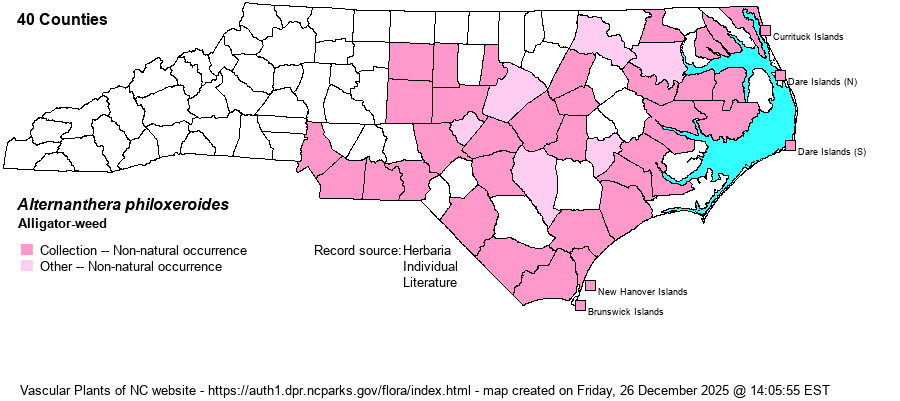| Author | (Martius) Grisebach | |
| Distribution | Throughout the Coastal Plain and Outer Banks; also in the eastern and central Piedmont. First collected in 1897 in New Hanover County at a ballast dump in Wilmington (Biltmore Herbarium, collector unknown); then again in Wilmington in 1930 by H.L. Blomquist, in 1946 at the Northeast Cape Fear River by A.E. Radford, and in 1951 at the Yacht Basin by L.A. Whitford. The first collection from the Brunswick side of the Cape Fear River was in 1949 by Radford. By 1955 it had been collected by E.O. Beal from Lake Waccamaw (Columbus County) and also by Beal way up in Currituck County. By the time the Flora of the Carolinas project was in full swing (1958) it had been found in several more counties. Today it is spreading inland in the Lumber, Pee Dee, Rocky, Deep, Haw, and Cape Fear systems -- and likely occurs in all counties in the eastern 55% of the state.
Native of South America; in N.A. VA, KY, and AR south to FL and TX; also CA. | |
| Abundance | Frequent to locally abundant in the Coastal Plain, rare in the Sandhills proper, and uncommon in the Piedmont. Now actively spreading, and some populations are dense enough to impede boat traffic in canals and rivers. This is classified as a noxious weed in a number of states. | |
| Habitat | Fresh to brackish rivers, fresh to brackish marshes, beaver ponds, natural lakes (Waccamaw, Phelps, Mattamuskeet), impoundments, natural ponds (rarely), wet cropfields, drainage ditches, roadside canals, forest clearings, ballast dump. Substrates vary from soft and muddy to rocky riffles. In most cases Alligator-weed prefers nutrient-rich waters resulting from waste disposal, farm field runoff, inefficient sewage treatment, etc. | |
| Phenology | Flowering and fruiting March-October. | |
| Identification | Alligator-weed is readily identified by its very long (up to 16 feet), floating or somewhat submerged, thick stems that intertwine to form dense patches or mats which may reach 3 feet high above the surface. The leaves are numerous and lance-shaped, dark shiny green with a whitish midrib. The inflorescences are ovoid, silvery white, and on long stalks. The long inflorescence stalks separate it from our other species in the genus. | |
| Taxonomic Comments | | |
| Other Common Name(s) | | |
| State Rank | SE | |
| Global Rank | GNR | |
| State Status | | |
| US Status | | |
| USACE-agcp | OBL link |
| USACE-emp | OBL link |

